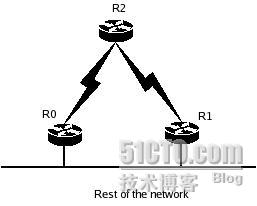Routing protocols, especially EIGRP, are very good at finding ways around network faults. I remember one time where we had a LAN failure, but a router on each side of the break happened to be connecting to the same site over two different WAN links, and EIGRP shunted all the LAN traffic through that office (via a low speed link) until we fixed the break. Though the LAN was technically up, the bandwidth available was so low that it didn’t work well.
This comes at the expense a larger query scope for the DUAL algorithm, which results in more
Stuck in Active (SIA) routes. In many cases you know if a particular router will never transit traffic (ie all traffic comes from, or to, networks attached to the router). These are called
stub zones (or areas). OSPF has these concepts, and so does EIGRP, it’s just that it’s not widely known.

R0 and R1 are distribution routers connected to the corporate backbone. R2 is connected over the WAN, and is a remote office.
From R2’s perspective, any routes coming from R0 should not be advertised back to R1, and vice-versa. Likewise, when going active on a router, R0 and R1 shouldn’t ask R2. But, by default, all of this happens to poor R2.
By configuring R2 as a stub you can choose what type of routes to advertise: connected, static, summary, or a combination of the three. You can also choose to advertise no routes, and rely on the distribution layer to handle this for you.
r2(config)#router eigrp 1
r2(config-router)#eigrp stub ?
connected Do advertise connected routes
receive-only Set IP-EIGRP as receive only neighbor
static Do advertise static routes
summary Do advertise summary routes
r2(config-router)#eigrp stub
On R0, we can now see that the neighbour is known as a stub, and that since I didn’t specify what type of routes to advertise, the defaults are connected and summary routes (ie not redistributed static routes). R0 also knows not to make any queries to R2 in the event that it goes active on a route.
r0#show ip eigrp neighbors detail
IP-EIGRP neighbors for process 1
H Address Interface Hold Uptime SRTT RTO Q Seq
(sec) (ms) Cnt Num
0 10.2.2.1 Se0.131 14 00:00:51 444 2664 0 39
Version 12.1/1.2, Retrans: 0, Retries: 0
Stub Peer Advertising ( CONNECTED SUMMARY ) Routes
Suppressing queries
1 10.50.0.2 Et0 10 00:01:22 23 200 0 40
Version 12.2/1.2, Retrans: 3, Retries: 0
Cisco has a document about
EIGRP stub routing, and
Optimal Routing Design has a section on it, which is where I originally learned about this feature.
转载于:https://blog.51cto.com/sense5/53530




 本文介绍如何通过配置EIGRP Stub路由器来优化路由选择,避免不必要的查询传播,减轻远程办公室路由器的负担。文章详细展示了配置过程及效果,并提供Cisco官方文档链接作为进一步阅读资料。
本文介绍如何通过配置EIGRP Stub路由器来优化路由选择,避免不必要的查询传播,减轻远程办公室路由器的负担。文章详细展示了配置过程及效果,并提供Cisco官方文档链接作为进一步阅读资料。
















 3万+
3万+

 被折叠的 条评论
为什么被折叠?
被折叠的 条评论
为什么被折叠?








